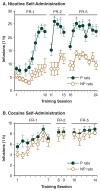Biological processes underlying co-use of alcohol and nicotine: neuronal mechanisms, cross-tolerance, and genetic factors
- PMID: 17373407
- PMCID: PMC6527043
Biological processes underlying co-use of alcohol and nicotine: neuronal mechanisms, cross-tolerance, and genetic factors
Abstract
Alcohol and nicotine are two of the oldest and most commonly used recreational drugs, and many people use both of them together. Although their ready availability likely contributes to the strong correlation between alcohol and nicotine use, several lines of evidence suggest that biological factors play a role as well. For example, both alcohol and nicotine act on a brain system called the mesolimbic dopamine system, which mediates the rewarding and reinforcing properties of both drugs. Modification of the activities of the mesolimbic dopamine system can interfere with the effects of both alcohol and nicotine. Another mechanism that may contribute to alcohol-nicotine interactions is cross-tolerance to the effects of both drugs. Finally, genetic studies in humans and of selectively bred mouse and rat strains suggest that shared genetic factors help determine a person's liability to use or abuse both alcohol and nicotine.
Conflict of interest statement
The authors declare that they have no competing financial interests.
Figures


Similar articles
-
Alcohol's actions on neuronal nicotinic acetylcholine receptors.Alcohol Res Health. 2006;29(3):179-85. Alcohol Res Health. 2006. PMID: 17373406 Free PMC article. Review.
-
The effect of alcohol and nicotine abuse on gene expression in the brain.Nutr Res Rev. 2009 Dec;22(2):148-62. doi: 10.1017/S0954422409990114. Nutr Res Rev. 2009. PMID: 19900347 Review.
-
Responses to cholinergic agonists of rats selectively bred for differential sensitivity to ethanol.Alcohol Clin Exp Res. 1991 Mar;15(2):270-6. doi: 10.1111/j.1530-0277.1991.tb01868.x. Alcohol Clin Exp Res. 1991. PMID: 2058804
-
Effect of a novel neurotensin analog, NT69L, on nicotine-induced alterations in monoamine levels in rat brain.Brain Res. 2008 Sep 22;1231:6-15. doi: 10.1016/j.brainres.2008.07.037. Epub 2008 Jul 19. Brain Res. 2008. PMID: 18687313
-
The putative role of extra-synaptic mesolimbic dopamine in the neurobiology of nicotine dependence.Behav Brain Res. 2000 Aug;113(1-2):73-83. doi: 10.1016/s0166-4328(00)00202-3. Behav Brain Res. 2000. PMID: 10942034 Review.
Cited by
-
Alcohol problems as a signal for sensitivity to nicotine dependence and future smoking.Drug Alcohol Depend. 2013 Oct 1;132(3):688-93. doi: 10.1016/j.drugalcdep.2013.03.018. Epub 2013 May 6. Drug Alcohol Depend. 2013. PMID: 23660243 Free PMC article.
-
Neuronal nicotinic acetylcholine receptors as pharmacotherapeutic targets for the treatment of alcohol use disorders.CNS Neurol Disord Drug Targets. 2010 Mar;9(1):60-76. doi: 10.2174/187152710790966597. CNS Neurol Disord Drug Targets. 2010. PMID: 20201817 Free PMC article. Review.
-
G-CuP: the effect of a forced oral glucose intake on alcohol craving and mesolimbic cue reactivity in alcohol dependence-study protocol of a randomized, double-blind, placebo-controlled crossover study.Trials. 2022 Aug 19;23(1):693. doi: 10.1186/s13063-022-06626-w. Trials. 2022. PMID: 35986409 Free PMC article.
-
"Essentially, All Models are Wrong, but Some Are Useful": A Preliminary Conceptual Model Of Co-Occurring E-Cig and Alcohol Use.Curr Addict Rep. 2017 Jun;4(2):200-208. doi: 10.1007/s40429-017-0148-9. Epub 2017 Apr 28. Curr Addict Rep. 2017. PMID: 29057201 Free PMC article.
-
Varenicline ameliorates ethanol-induced deficits in learning in C57BL/6 mice.Neurobiol Learn Mem. 2008 Jul;90(1):230-6. doi: 10.1016/j.nlm.2008.03.002. Epub 2008 Apr 14. Neurobiol Learn Mem. 2008. PMID: 18411066 Free PMC article.
References
-
- Acheson A, Mahler SV, Chi H, de Wit H. Differential effects of nicotine on alcohol consumption in men and women. Psychopharmacology (Berlin) 2006;186:54–63. - PubMed
-
- Barrett SP, Tichauer M, Leyton M, Pihl RO. Nicotine increases alcohol self-administration in non-dependent male smokers. Drug and Alcohol Dependence. 2006;81:197–204. - PubMed
-
- Bierut LJ, Rice JP, Goate A, et al. A genomic scan for habitual smoking in families of alcoholics: Common and specific genetic factors in substance dependence. American Journal of Medical Genetics. 2004;124:19–27. - PubMed
-
- Bowers BJ, McClure-Begley TD, Keller JJ, et al. Deletion of the alpha7 nicotinic receptor subunit gene results in increased sensitivity to several behavioral effects produced by alcohol. Alcoholism: Clinical and Experimental Research. 2005;29:295–302. - PubMed
-
- Butt CM, Hutton SR, Stitzel JA, et al. A polymorphism in the alpha4 nicotinic receptor gene (Chrna4) modulates enhancement of nicotinic receptor function by ethanol. Alcoholism: Clinical and Experimental Research. 2003;27:733–742. - PubMed
Publication types
MeSH terms
Substances
LinkOut - more resources
Full Text Sources
